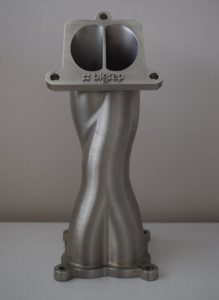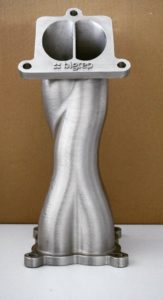 3D printing is affecting nearly every industry in some way, but one industry it’s having a major impact on is the automotive one. While the applications may not all be as flashy as 3D printed cars, they’re still affecting the industry in important ways. Automotive manufacturers are saving time, money and resources by using 3D printing for prototyping and even end-use parts. The possibilities of 3D printing in the automotive industry are vast – a single car contains about 30,000 different components, of different sizes and materials, manufactured using different methods. How many of those components could be prototyped or manufactured using 3D printing?
3D printing is affecting nearly every industry in some way, but one industry it’s having a major impact on is the automotive one. While the applications may not all be as flashy as 3D printed cars, they’re still affecting the industry in important ways. Automotive manufacturers are saving time, money and resources by using 3D printing for prototyping and even end-use parts. The possibilities of 3D printing in the automotive industry are vast – a single car contains about 30,000 different components, of different sizes and materials, manufactured using different methods. How many of those components could be prototyped or manufactured using 3D printing?
It’s not just the small parts that lend themselves to being 3D printed – not when you have a big 3D printer. BigRep, as its name suggests, is known for large-scale 3D printing, and it recently saw its BigRep STUDIO 3D printer play a role in prototyping an exhaust manifold, as part of research BigRep is conducting with Polymertal. The exhaust manifold is a large part that connects to each exhaust port on the engine’s cylinder head and funnels the hot exhaust down to a single exhaust pipe.
 Normally, manifolds are manufactured via metal casting. They need to be able to withstand a high-temperature environment around the car’s engine, so they must be highly resilient and robust. BigRep and Polymertal were looking for a faster and more cost-effective way to perform fit-form-function manifold testing, in order to reduce costs and development time. They also wanted to improve the prototype’s mechanical properties in order to make it more closely resemble a finished part from cast metal.
Normally, manifolds are manufactured via metal casting. They need to be able to withstand a high-temperature environment around the car’s engine, so they must be highly resilient and robust. BigRep and Polymertal were looking for a faster and more cost-effective way to perform fit-form-function manifold testing, in order to reduce costs and development time. They also wanted to improve the prototype’s mechanical properties in order to make it more closely resemble a finished part from cast metal.
To do so, they 3D printed a large manifold using the BigRep STUDIO. The STUDIO was developed in response to customers who wanted something a bit smaller than the company’s BigRep ONE, but with the same capabilities. It’s still plenty big, with a build size of 500 x 1000 x 500 mm, but a bit more reasonable, and was perfect for prototyping something like an exhaust manifold. The part was 3D printed in 15 hours using PLA and PRO HT filament, and then coated with 20-micron-thick nickel in a direct metalization plating process. The material cost was less than €20.
As we’ve seen, plating 3D printed parts using Polymertal’s technology creates light, strong objects. Plating the manifold gave it increased heat and chemical resistance, as well as increased strength. Manufactured quickly and at low cost, the part had mechanical properties similar to a finished part, making it suitable for real functional testing. The quality of the part and the speed at which it was manufactured gave BigRep and Polymertal confidence that the combination of 3D printing and metal plating can be used for faster, improved testing of other new automotive component designs.
With tens of thousands parts in an average car, there’s a lot of room to experiment, and automotive manufacturers could benefit from the time and cost savings that 3D printing prototypes allows. In particular, a hybrid approach like that used by BigRep and Polymertal is useful because it produces a prototype that’s close to the final part, allowing for not only faster and cheaper production but more effective testing.
Discuss this and other 3D printing topics at 3DPrintBoard.com or share your thoughts below.
[Images courtesy of BigRep]
Subscribe to Our Email Newsletter
Stay up-to-date on all the latest news from the 3D printing industry and receive information and offers from third party vendors.
You May Also Like
3D Printing Unpeeled: Biofuel Waste to Filament & Sustainable Photopolymers
I can’t ever remember a day with so many potentially high impact news stories have come out. In one story, we all know that there are problems with the safety...
Finnair Hires AM Craft to 3D Print Plastic Parts for Aircraft Interiors
Riga-based AM Craft, a supplier specialized in 3D printing aviation components and certified under EASA Part 21G, announced a significant achievement today. The company will assist in upgrading Finnair’s A320...
3DPOD Episode 198: High Speed Sintering with Neil Hopkinson, VP of AM at Stratasys
Neil Hopkinson, a pioneering 3D printing researcher, played a pivotal role in developing a body of research that is widely utilized today. He also invented High Speed Sintering (HSS), also...
3D Printing Webinar and Event Roundup: May 12, 2024
Webinars and events are picking up in the AM industry this week! ASTM International continues its Professional Certificate Course and Stratasys continues its advanced in-person trainings, while 3D Systems is...



































